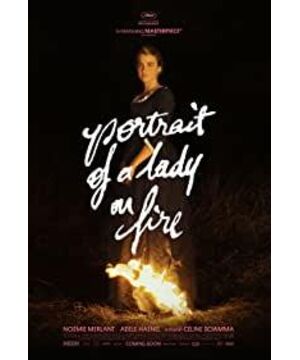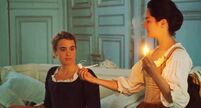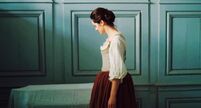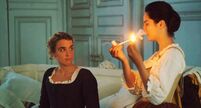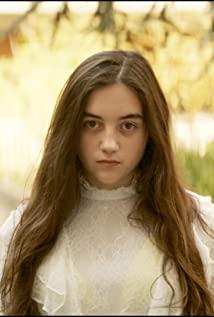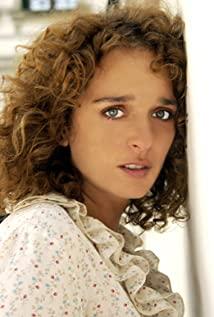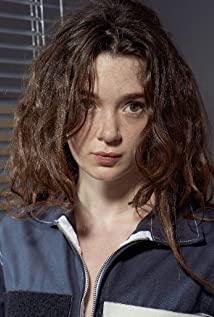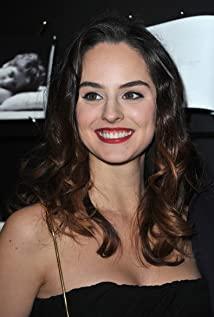"People should continue to live as always, in the desert, but with all the love in their hearts that consists of a kiss, a word, and a look." After reading "Portrait of a Burning Woman", I remembered this sentence by Duras.
The movie has a lot of stamina. After watching it three times in a row, I went to see many interviews with directors and actors. I was deeply impressed by the talent of director and screenwriter Celine Sciamma. In the interview, Céline repeatedly mentioned the word gaze. If I was there, I would like to ask her whether she first thought of "gaze", the most common intimacy between lovers, and then constructed a relationship with her. This love story that is closely related to the action, or do you first think of the need for the painter and the painted subject to constantly watch and be watched, silently intertwined eyes, and then use the plot of "gazing" to run through the whole plot?
At the beginning of the film, the painter comes to an island with a secret mission to paint a portrait of the noble lady Héloïse before she is known. When the two met for the first time, the painter followed behind Héloïse with a curious and distant gaze; when they stood side by side on the seaside, they were secretly observing because they were about to complete the painting; when they looked back, they looked at each other. The eyes that were found and avoided in panic.
"I had to get close enough to her to paint her soft earlobes, and the hair that covered the tips of her ears, which took on a warm, transparent tone, and the center hole, which was thicker; in the light , her cheeks became the brightest part of her face, making people unable to take their eyes off." This line is accompanied by Noémie Merlant's soft voice, which is extremely ambiguous.
The film uses a lot of close-ups, as if we were the painter's eyes, seeing Héloïse's hair, neck, face, ears, eyelashes, and blue eyes looking back. If you watch the movie carefully, you will find that Héloïse is also peeking at her from the corner of his eye. There is a word called gaze perception. Even when we're not looking at each other, we can still feel that the other person is looking at us.
Facing the painter's slightly aggressive eyes, Héloïse chose to look back most of the time. This kind of looking back started as a contest between eyes, as if we had all been stared at inexplicably by strangers, and then looked back to see who would escape first - but as the plot develops, this kind of The meaning of looking back changed, from sullen, serious, and slowly to curious, appreciative, and even serious-until later, when the painter played music to her awkwardly, Héloïse looked at the painter for the first time. love. Yes, before the official painting, the two were secretly watching each other all the time.
When the first painting was completed, Héloïse said it was not like her. In fact, I think the painter is not satisfied with this painting, because Héloïse's mother asked her the day before, is this your satisfactory work? She answered slightly hesitantly: I think so.
Héloïse is represented in the painting as the wife and mother of an aristocratic family—as she is expected to be. However, Héloïse disagreed, and she asked the artist: "Is this what you see in me?" This sentence led to the second "gaze" of the film. Faced with this question, the painter was obviously a little surprised, and replied: "It's not just me", "it also includes the rules, techniques, and the use of color and light". This "not just me" is the male gaze in society and art.
The so-called male gaze refers to that in a patriarchal society, women are placed in the position of the watched, objectified, appreciated, used, and shaped into a "feminine" first in line with the expectations of the patriarchal society. duality. The male gaze pervades all aspects of life, and women who have been immersed in such an environment for a long time will subconsciously follow this perspective, identify with the values attached to this perspective, and lose the uniqueness of women as individuals.
That's why when Héloïse said, "This portrait doesn't look like me, I can understand it; but she doesn't look like it was from you, and I feel sorry for that", the painter was stabbed in the pain and ruined the painting in shame and anger. It can also be seen from the subsequent plot that the painter is talented, but he cannot even sign a painting just because of his gender.
Céline said in an interview that the 18th century (the background period of the film) was a special period for many female artists because there were many anonymous female painters, many of whom were erased by art history . At this point, the movie is no longer a simple love story. It leads to a deeper question: whose perspective does the subject in art start from?
Also because of the destruction of the first painting, there is an official second painting, and there are also fair and bright eyes. At this time, facing Héloïse's gaze, the painter was no longer calm. Obviously it should be taken for granted, but it has the meaning of dodging - this is already the look of a crush. After that, accompanying the maid in the kitchen, the eyes of the two were already attracted to each other and couldn't take them away.
In the studio dialogue, the two exposing their behavior habits to each other is more like a high-level tease, "When you look at the person in the painting, who am I looking at?" It's an eye gaze with someone who is close (or wants to develop further intimacy) and usually "slips" from the eyes to the lips and the body below the lips - which is already a The obvious hint was - at this moment, there was only lust surging in their eyes.
The second day after accompany the maid to the abortion, the scene in the studio is the warmest moment in the whole film, and also my favorite scene, Héloïse looks at the painter, the painter paints for her, both of them can't stop laughing meaning. For the second painting, Héloïse is satisfied, "maybe because I know you better", the painter said, "maybe because I have changed", says Héloïse.
Noémie Merlant also mentioned the significance of the second painting in the interview: this new portrait that she finds with this collaboration, this love story, these sorority moments—she finds a portrait that looks like more than Héloïse and looks like more herself as an artist, as a woman.
As parting approached, the eyes of the two were full of reluctance to look at each other, and they were reluctant to leave their eyes for a second; until the moment of real parting came, the eyes of the two were determined and fierce, to engrave each other into their memories The kind of ferocity in. At the end of the film, when the painter saw the portrait on p.28, Héloïse also looked at the viewer outside the screen, and the painter smiled knowingly - at this moment, don't their eyes meet again?
At the end of the film, in the 3-minute music piece, Adele Haenel contributed a very good long shot. The film stopped abruptly in Héloïse's turbulent emotions of tears and laughter. The director did not shoot the front and back shots, just to let the audience The angle of view is like the gaze that the painter can't take away, condensing on Héloïse - if I were a painter, I saw the love of this life in front of me and couldn't recognize it, then I might still be like that night by the campfire, my heart Such as fire, eyes burning hot.
As an audience in the movie theater, do you also look back on your youth, remembering the reckless and sad ending when you were young, and what kind of mixed feelings are in your heart? This is exactly the third gaze the director is expecting: i hope you feel seen...i mean, you look at the film, but the film is also looking at you...it's cinema unveiling itself so that suddenly there is room for you , there is room for your own love stories, for your own souvenir——remembrance.
Regarding the original intention of creating this film, Céline mentioned: At first, I wanted to write a love movie, a movie dedicated to love, with love as the center, to find it patiently, how did the initial fire of love come about, and how Development, how it flourished; it is also a memory of love, what does it leave us, and it is also about the politics of love, the philosophies of love... Also because I want to work with Adele again (I think the last sentence is the point Ah! Adele is the director's ex-girlfriend). To borrow a line from the play, "Not everything in the world is so short-lived, such as a deep love that comes from the heart."
View more about Portrait of a Lady on Fire reviews


